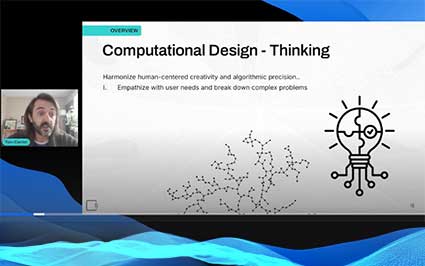Slate is launching a monthly webinar series on technology and construction. Our kickoff session on July 17th 11am PST / 2pm EST featured Slate design expert, Thomas C. Carrier, with CPO, Joel Hutchines as moderator. Dive into the world of computational design thinking during this 30-minute session, followed by a live Q&A.
▶️ View the webinar event on Linkedin on the Slate LinkedIn page.
—
“[Think about] The data structures that you can create using computation design.. and then use things like machine learning and AI to do new and exciting things with it.”
Thomas C. Carrier, Slate Technologies
Computational Design
For this webinar, our presenter, Thomas Carrier, gave an overview of what computation design approach may include in practice. Some of the main points included:
- How to translate repeatable, valuable processes into code
- Create a new, collaborative, and dynamic process
- Reduce limitations of time and resources
- What about generative design?
➡️ Download a copy of the webinar presentation PDF.
The Approach of Computational Design Methods
The first section of the webinar covers the approach to computational design. This includes methods for combining parameters and algorithms. In practice, combining parameters and algorithms create opportunities to streamline processes. For example, identifying valuable processes and translating that into a code that is repeatable. This, in turn, creates a new, collaborative and dynamic process. One of the efficiencies with this approach is the reduction in limitations. Resources like time, materials, effort, are optimized.
Access and Computational Design
My utilizing methods like computational design bridges art, science, and technology. There are many accessible mediums in which the principals of design are utilized. These include, but are not limited to:
- Hand drafting
- Physical modeling
- 2D CAD drafting
- Digital Fabrication
- 3D modeling
- Advance manufacturing
- Building information modeling
- Data structures
- Data simulation
- Machine learning + AI
Tools in the construction and technology space utilize art, science, and other algorithmic data to produce visualizations of different user inputs. Design principles and machine learning in the construction industry are making more processes highly visible and accessible to more people. Decision makers, investors, project managers, all have the ability to give feedback on data inputs and see the practical application through different data simulation tools, machine learning, artificial intelligence, and software.
In summary, the construction industry needs to ditch the clipboard in favor of software that can revolutionize on site delivery and progress tracking. With the right data structures in place, more centralized reporting can give stakeholders and project managers streamlined systems to visualize project completion to stay on time and under budget.
—
To learn more about Slate’s Generate tool, mentioned on today’s webinar by visiting our preconstruction page.
📲 Want to talk to the awesome team at Slate? Send a message to info@slate.ai or visit our contact page and fill out the form.

